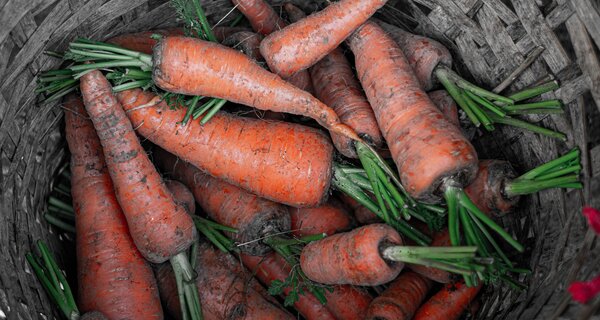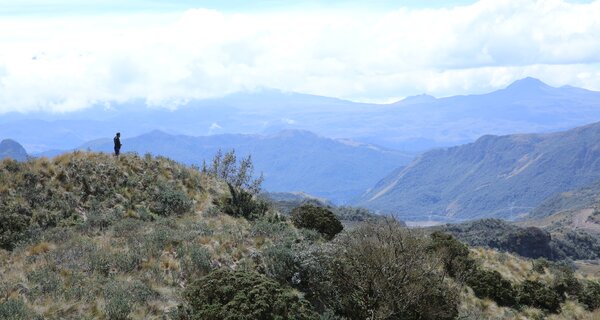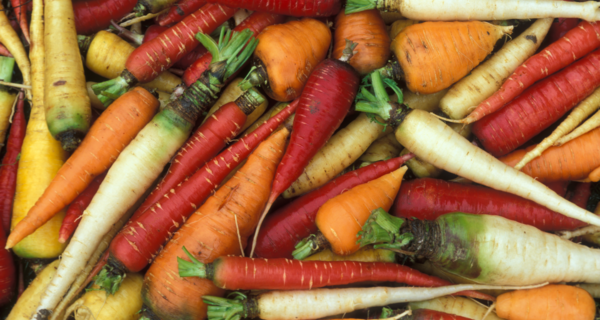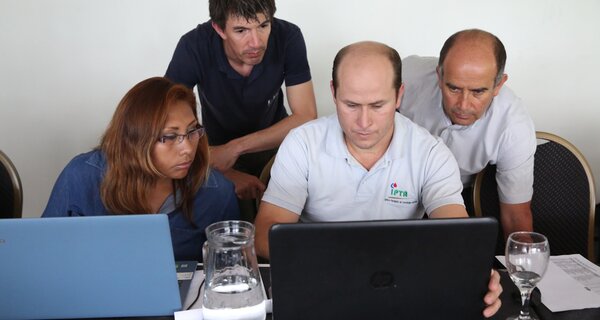Climate Proofing the Carrot: Where Flavor Meets Stress Tolerance
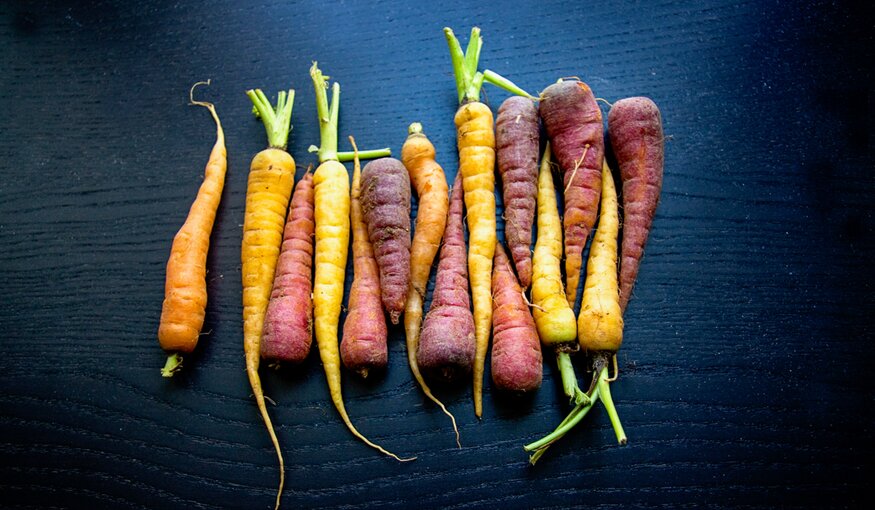 The Crop Wild Relatives Project utilizes the traits of wild relatives to improve heat, drought, and salt tolerance in cultivated carrots.
The Crop Wild Relatives Project utilizes the traits of wild relatives to improve heat, drought, and salt tolerance in cultivated carrots. 30 August 2022
Carrots are tasty, versatile, and – while your tomatoes and cauliflowers go all squishy – easy to store for a long time. Most importantly, carrots are packed with micronutrients, especially the precursor of vitamin A.
But carrots aren’t immune to the changing climate. We take a closer look at the multi-country effort in which researchers are developing carrots to withstand new stresses.
Half a Carrot a Day
“Half a carrot a day is enough to meet an individual’s need for vitamin A,” says Philipp Simon, USDA/ARS Research Geneticist and Professor for Horticulture, University of Wisconsin-Madison.
Vitamin A deficiency weakens immune systems, making diarrhea and measles deadly diseases, and can even lead to blindness. There are some shocking statistics from the World Health Organization (WHO), which estimates that some 220 million preschool children are deficient in the vitamin, leading to up to half a million children going blind each year, half of whom die within a year of losing their sight. All of which is completely preventable. “A square meter of land could provide all the vitamin A needed for two adults, for a whole year,” says Simon.
But to eat half a carrot a day you need access to carrots. And to have access to carrots, someone must grow them – which is becoming far harder to do in an increasingly unpredictable climate. To grow carrots, you need loose and well-watered soil. In many places, soils are becoming drier and saltier, even in parts of the world that can afford high-input farming systems, such as the United States.
“A few years ago, there wasn’t much demand in the United States for carrots adapted to climate change,” says Simon. “That’s changed, particularly now that there has been a four-year drought in California, where most US carrots are grown.”
Breeding Climate-resilient Carrots
Simon led the carrot pre-breeding and evaluation project under the recently completed Crop Wild Relatives Project. This involved researchers from Bangladesh, Pakistan, India, Taiwan, and the US teaming up to first characterize selected wild carrots for stress tolerance in extreme field conditions, then cross the most tolerant ones with a range of preferred local cultivated varieties, the aim being to develop carrots better adapted to hotter, drier and more saline conditions. In short: flavor meets stress tolerance.
“Some wild carrots are surviving in very harsh conditions without any human intervention,” says Simon, who has worked in carrot genetics for almost 40 years. “That’s a good sign, it tells us they have developed traits that make them more tolerant to heat, drought, and salt. We can use that genetic variation to improve the commercial crop.”

(Photo credit: Adam Bolton)
A family photo. Wild, white carrots, next to their long, slender and orange cultivated cousins. As part of the Crop Wild Relatives Project, wild and cultivated carrots were crossed to breed carrots tolerant to heat, drought and salinity which also look – and taste – good.
 Abdur Rahim (center), professor at the Bangladesh Agricultural University, with participants in the International Carrot Conference held in early 2020.
Abdur Rahim (center), professor at the Bangladesh Agricultural University, with participants in the International Carrot Conference held in early 2020.
 Abdur Rahim (center), professor at the Bangladesh Agricultural University, and Philipp Simon (center in white shirt), USDA/ARS Research Geneticist and Professor for Horticulture, University of Wisconsin-Madison, with participants in the International Carrot Conference held in early 2020.
Abdur Rahim (center), professor at the Bangladesh Agricultural University, and Philipp Simon (center in white shirt), USDA/ARS Research Geneticist and Professor for Horticulture, University of Wisconsin-Madison, with participants in the International Carrot Conference held in early 2020.

(Photo credit: Majharul Mannan)
Professor Rahim (left) talks at a farmers’ meeting in Satkhira, Bangladesh. Rahim is the project leader of the carrot pre-breeding work carried out at Bangladesh Agricultural University, and has organized many training courses on carrot cultivation.

(Photo credit: Adeel Ijaz Shah)
Master student Adeel, from the University of Sargodha in Pakistan, proudly shows off carrots of all different shapes and colors he just pulled out of the ground.
A New Crop for Bangladesh
“In Bangladesh, carrot is a new crop,” says Abdur Rahim, professor at the Bangladesh Agricultural University. “Demand is increasing day by day.”
Unfortunately, yearly monsoons blow the salty water of the Bay of Bengal inland. Ten percent of the land is affected by salinity and about 15% of Bangladesh is in a drought and heat stress area. As a result, production is finding it difficult to keep up with demand.
“To meet the demand, we need new varieties that will grow well under our challenging conditions,” says Rahim. “In fact, this is the first project using crop wild relatives for the stress areas of Bangladesh.”
“As the demand for carrots is high all over Bangladesh, we need good varieties to grow in stress areas,” says Abdur Rahim, Professor at the Bangladesh Agricultural University.
Case in point: Satkhira is in the South of Bangladesh, on the Bay of Bengal, and the field sites of the project are swamped with salt. In most growing seasons, soil salinity levels are about triple what your average carrot crop can handle. But, amazingly, some of the wild carrots survived these harsh conditions.
“We were very excited to see some very promising results from initial trials being carried out in the country’s drought-prone north and the saline soils of the south,” says Benjamin Kilian, who coordinated the Crop Wild Relatives Project. “These will soon translate into new varieties that farmers in Bangladesh will be able to grow under conditions that have so far defeated them.”
An Old Crop in Pakistan, but New Varieties Needed
At the other end of the Himalayas, in Pakistan, carrots are already more established, with the red carrot variety ‘T-29’ being essential for many traditional Pakistani dishes. However, Pakistan’s carrot yield is much lower than its potential; it has even been declining over the past 20 years.
“We are using plants that have been found to be tolerant to heat, drought and salinity in both Bangladesh and Pakistan and trying to cross those plants with cultivated carrots,” says University of Wisconsin PhD student Adam Bolton. “Breeding takes a lot of time, especially when you are working with wild material. We’d be thrilled if we could get new varieties out there in the next 10 years.”
But already the results look promising, with five of the pre-bred lines showing exceptional performance, with both stress tolerance and high yield. Seeds of these are being multiplied and will be made freely available to growers, seed companies and researchers.
Helping Put an End to Vitamin A Deficiency
No matter if your soil is salty or dry, or if you prefer red or orange carrots, eating half a carrot a day should be part of everybody’s daily diet. This project is helping ensure this will be possible, despite climate change.
All agronomic and genetic data generated throughout this project is being shared on the online database CarrotOmics.
Seeds of the improved wild-derived carrot lines developed during this project are stored at the World Vegetable Center and the USDA-ARS and shared under the terms and conditions of the Standard Material Transfer Agreement (SMTA) within the framework of the Multilateral System of the International Treaty for Plant Genetic Resources for Food and Agriculture.
Categories: Crop Wild Relatives, Carrot, Food Security, Nutritional Security
About the Crop Wild Relatives Project
The Crop Wild Relatives Project was developed to collect important species of crop wild relatives, ensure their long-term conservation and facilitate their use in breeding new, improved crops. This 11-year project was launched in 2011 with USD 50 million in funding from the Government of Norway. Managed by the Crop Trust with the Royal Botanic Gardens, Kew, the project was implemented in partnership with national and international genebanks and plant breeding programs around the world. The work is continuing under the “Biodiversity for Opportunities, Livelihoods and Development” (BOLD) Project, which is also funded by the Government of Norway.

